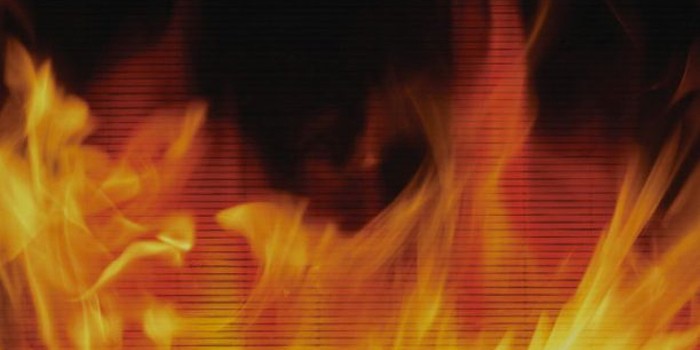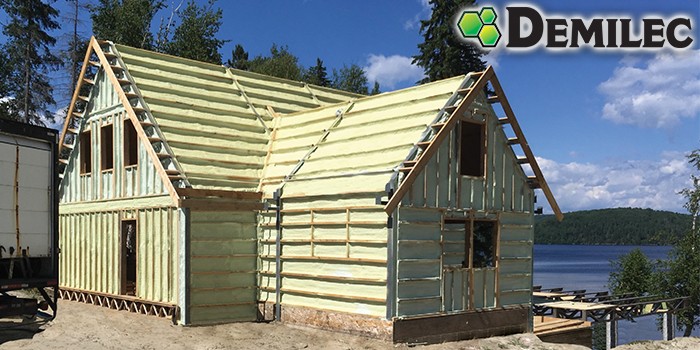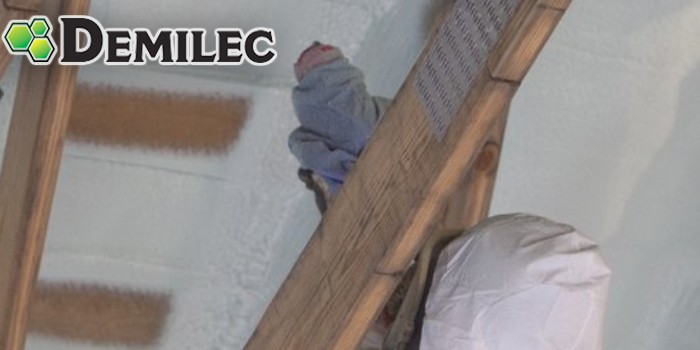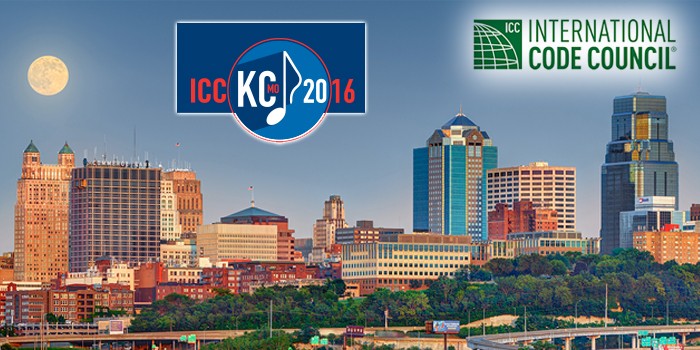Fire Code Requirements for SPF applications - Mason
Fire Code Requirements for SPF applications
Anyone who has studied the International Building Code and the International Residential Code knows that it can be confusing to determine how to comply with the various fire test requirements of the International Code Congress building codes when installing SPF insulation or roofing. When do you need a thermal barrier or ignition barrier? How do you test for thermal barriers and ignition barriers? Are there exceptions? Are there other fire tests required? What kind of fire tests are there? How do they work? How are they used to qualify materials? And where does the ICC Evaluation Services fit into all of this?
This series of articles will attempt to provide some guidance in the rules that govern the SPF industry in regards to code compliance. We will review the different requirements for residential and commercial insulation applications and review the rules for roofing applications. We will also take a look at the fire tests used and the ICC Evaluation Report process.
International Residential Code (IRC) Fire Test Requirements:
According to the International Residential Code (IRC) Section 316.4, if a foam plastic (such as SPF) has the minimum ASTM E 84 surface burning indexes of 75 flame spread and 450 smoke development or less and is covered with a thermal barrier, it can be used in most interior insulation applications.
A building code official can review the foam plastic’s material data sheets to determine if the foam complies with the building code surface burning characteristic requirements. In these circumstances, an ICC Evaluation Report may not be required by the code official to determine compliance if a code designated thermal barrier is used.
However, if the manufacturer wishes to use an assembly that does not have a prescriptive code thermal barrier or ignition barrier then the code official would most likely rely on an ICC Evaluation Report that addresses the exceptions and the specific applications to which it applies.
Surface Burning Characteristics:
ASTM E 84 (foam plastic installed 4 inches or less): E -84 is the test procedure used to determine surface burning characteristics of foam plastics installed in thickness 4 inches or less. Foam plastic used for insulating interior walls, ceilings and floors of residential buildings requires foam having a flame spread index of 75 or less and smoke developed index of 450 or less.
NFPA 286 (foam plastic installed more than 4 inches): The standard E 84 test apparatus does not have the capability of testing samples greater than 4 inches. If the design calls for greater thickness of foam plastic insulation, greater thicknesses of SPF can be tested (covered with a thermal barrier) in a small room corner test such as NFPA 286 (with the acceptance criteria of Section 302.9.4) can be used to achieve code approvals of foam plastics. When using NFPA 286 to qualify a foam plastics the following criteria is used:
Section 301.9.4: Alternate test method: ...Materials tested in accordance with NFPA 286 shall meet the following criteria:
- During the 40 kW exposure, flames shall not spread to the ceiling
- During the 160 kW exposure, the interior finish shall comply with the following:
2.1. Flame shall not spread to the outer extremity of the sample on any wall or ceiling
2.2. Flashover, as defined in NPFA 286, shall not occur - The total smoke released throughout the NFPA 286 test shall not exceed 1,000 m2.
- Other small room corner tests which can be used to qualify thicknesses of SPF greater than four inches include UBC 26-3 and UL 1715.
Thermal Barriers: All foam plastics (including spray polyurethane foam) used in residential building construction are required to have a thermal barrier installed that separate the foam from the interior of the building. The IRC specifically lists ½” gypsum drywall as an acceptable thermal barrier material. In addition to drywall other coverings can be qualified as thermal barriers using a modified 15-minute ASTM E 119 (or UL 263) test procedure. In order to qualify, the thermal barrier must limit the increase in surface temperature of the foam (under the thermal barrier material) to 250 degrees after 15 minutes of fire exposure. If the material passes the ASTM E 119 as a thermal barrier material, must also pass a room corner test applied to specific types of foam plastics (SPF, EPS, XPS, etc) to demonstrate that it will remain in place during a fire event. This qualifies the thermal barrier to be used on the generic type of foam plastic with which it was tested. Thermal barrier manufacturers would submit their test data to ICC Evaluation Services to review and an evaluation report provided on that material.
Special Approvals: There are some coverings that provide excellent fire protection over foam plastics but cannot pass the ASTM E 119 thermal barrier test (some intumescent coatings come to mind). The IRC provides a way for these materials to be tested as an assembly with specific foam plastics.
Section 316.6 of the IRC allows foam plastic assemblies to be used without a thermal barrier if the application is “specifically approved on the basis of one of the following approved tests: NPFA 286 with the acceptance criteria of Section R 302.9.4, FM 4880, UL 723, UL 1040 or UL 1715. The specific approval shall be based on the actual end use configuration and shall be performed on the finished foam plastic assembly in the maximum thickness intended for use.”
Under typical conditions, the foam manufacturer would have a design or assembly tested, and then submit their data and results to the ICC Evaluation Services for review. If the ICC evaluation services engineers approve the test results, they would include that specific design or material combination in an evaluation report for that application.
Coverings used over foam plastics that pass a test under the special approvals section are not considered thermal barriers. A thermal barrier must also pass the ASTM E 119 thermal barrier test protocol.
Exceptions to the Thermal Barrier Rule: There are exceptions to the thermal barrier requirements in the IRC code listed in Section 316.5. The following items are a few examples listed in the IRC code.
- Foam plastic covered a one inch thickness of concrete or masonry
- Foam plastics used in roofing applications (although roof coverings must be tested using other methods.)
- Bare sprayfoam 0.5 to 2.0 lbs per cubic ft density (open or closed cell) can be installed without a thermal barrier to sill plates and headers so long as the foam is a maximum thickness of 3.35 inches, has a flame spread rating of 25 or less and a smoke developed rating of 450 or less in accordance with ASTM E-84.
- Attics and crawl spaces do not require a thermal barrier and can use an ignition barrier instead.
Ignition Barriers: When foam plastics are used in attics and crawlspaces, they still must be separated from the interior space with a thermal barrier. However, in attics and crawlspaces where entry is only for service of utilities (not used for storage or living space), the foam plastic may be separated from the space in the attic or the space in the crawlspace with an ignition barrier instead of a thermal barrier.
Code designated (prescribed) ignition barriers include:
- 1-1/2 inches of mineral fiber insulation (rockwool or unfaced fiberglass)
- 1/4 inch of wood structural panels
- 3/8 inch particle board
- 1/4 inch hardboard
- 3/8 inch gypsum board
- Corrosion resistant steel having a base metal thickness of 0.016 inch.
Specific Approvals: The building code does not specify a test that can be used to test and approve alternate materials as ignition barriers (such as intumescent coatings or other coverings.). So the foam plastic industry has relied on the ICC Evaluation Services to provide the guidance on which test procedure should be used to gain an exception to the ignition barrier requirement in attics and crawl spaces. The ICC ES has adopted a modified NFPA 286 test to qualify alternated assemblies to the prescribed ignition barrier assemblies in the building code. (This test protocol can be found in Acceptance Criteria AC 377, Appendix X).
SPF Roofing: All roofing systems used in residential construction must be rated class A, B, or C in accordance with UL 790 (or ASTM E 103) The A, B, or C designation is an indicator of how far the flame front travels across the sample during the test (A being the best). For approvals over combustible roof decks, a burning brand test is also conducted to test the roof system’s resistance to burn through. FM Class 1 roof covering listing can also qualify a roof covering system for residential approval.
SPF Roof systems must also be separated from the interior with a thermal barrier or specific code prescribed wood deck.
SPF used in roofing applications must have a flame spread index of 75 or less in accordance with ASTM E 84, but smoke is not limited.
(The following table contains examples of foam plastic applications and fire test requirements for the International Residential Code)
IRC Requirements Relating to Fire Exposure
Application |
Description |
Test |
Value Required |
|
Foam plastics used in interior walls, ceilings, floors |
Flame spread and smoke developed indexes |
E-84 |
75 flame spread |
|
Foam plastics used in interior walls, ceiling & floors (more than 4 inches |
Flame and smoke |
UL 1715, FM 4880, UBC 26-3, NPFA 286 |
Pass if max flames and smoke recorded at specific time intervals up to 15 min |
|
Thermal barriers used of generic foam plastics used in interior walls, ceiling & floors |
Thermal barrier |
E 119 |
Pass w/ 250 or less temperature at foam surface (15 min of fire exposure3 |
|
Foam plastics used in attics & crawl space |
Prescriptive ignition barrier |
None |
Code designated ignition barrier |
|
Roofing |
Flame spread index |
E 84 |
75 flame spread |
|
Exterior flames (and burning brand for combustible decks) |
UL 790 |
Class A, B or C min |
|
|
Specific Approvals |
Room corner tests specific to the application |
UL 1715, FM 4880, UBC 26-3, NFPA 286 |
Time pass without flames out the front |
|
Specific Approvals (alternative assemblies to ignition barriers |
Room corner test specific to the application |
NPFA 286 (as modified in AC 377, Appx. X) |
More than 4 min 18 seconds to flashover |
History of Fire Tests Relating to Foam Plastics and SPF: (interior residential applications)
ASTM E-84; the Steiner Tunnel Test:
All building materials can burn, release heat and toxic gases causing injury or death. All building materials react differently in a fire situation. The history of testing interior finishes for fire characteristics goes back to the early part of the 20th century. But it took a series of disastrous fires in the 1940s for the public to raise concerns sufficient to take action.
The now famous fires at Boston’s Coconut Grove nightclub in Boston, Chicago’s LaSalle Street Hotel and Atlanta’s Winecoff Hotel killed more than 670 people and prompted the public to demand a reliable test to determine the flame spread and smoke development of a building's interior finishes in fire situations and to classify them for use in buildings. (Source: Randy Laymon; Assessing the Burning Characteristics of Interior Finish Material, Fire Protection Engineering; September, 2004,)
The most widely accepted test protocol was the Steiner tunnel test developed by Albert Steiner of Underwriters Laboratories from the early 1920s to the 1940s. Steiner used red oak as a baseline material due to the common use of it as a flooring material. The Steiner tunnel is a furnace chamber 25 feet long that measures flame spread and smoke development.
The test indexes materials based on comparisons of the surface flame spread and smoke generated to those obtained from tests of mineral fiber cement board and select grade red oak flooring.
The test procedure was first published by UL in 1950 and became ASTM E 84 Standard Test Method for Surface Burning Characteristics of Building Materials in 1961. How well your material performed against the baseline determined the classification of your building product.
Procedure:
The test is conducted with the specimen in the ceiling position of the tunnel with the surface to be evaluated exposed face down to the ignition source. The fire test chamber (tunnel) is calibrated when a 10 minute test of rod oak decking will pass flame out of the end of tunnel in 5 minutes, 30 seconds (plus or minus 15 seconds). Mineral fiber cement board forms the zero point for both flame spread and smoke developed indexes, while the red oak flooring flame spread and smoke developed index is set as 100.
Flame is reported numerically from 1 to 100
Smoke generated is reported numerically from 1 to over 1000
Building Codes list the flame spread and smoke ratings of the material or product into 3 classes:
Class I (or A), Class II (or B) or Class III (or C) or unrated
- Class I: Flame spread 0-25; Smoke Developed 0-450
- Class II: Flame Spread 26-75; Smoke Developed 0-450
- Class III: Flame Spread 76-200; Smoke Developed 0-450
Foam Plastics and the FTC Consent Decree:
For the next 20 years, the Steiner tunnel test became the predominant method of determining if an interior finish was an acceptable risk for use in construction. In the later 1960s to early 1970s, foam plastic was becoming a popular alternative insulation in buildings. Many companies advertised the foam based on the Steiner tunnel test as non-burning, non-combustible and self-extinguishing
Most foam plastics could achieve Class I and Class II ratings on their products, but the flame ratings did not accurately predict the relative safety of their use in construction. Thermoplastic foams such as EPS and XPS would melt during the test generating misleading low flame spread values. Thermoplastic materials such as polyurethane foam could generate flame or flashover conditions if large surface areas became involved in a fire.
After a series of fires involving foam plastics, the Federal Trade Commission stepped in and demanded the foam plastics industry address the issue. In 1974, the Federal Trade Commission entered into a Consent Decree and Order with the foam plastics industry (as represented by the Society of the Plastics Industry) that prescribed specific marketing and sales practices of foam plastics. The Consent Decree and Order stated that all parties selling or installing foam plastic:
- “Cease and desist from using, publishing, or disseminating (or encourage others to use, publish or disseminate) descriptive terms such as “non-burning”, “self extinguishing”, or “non-combustible” in connection with cellular foam plastics products unless they perform as described under actual fire conditions;
- Refrain from referencing numerical flame spread ratings in connection with cellular foam plastic products based on small-scale flammability tests without a detailed disclaimer noting that the ratings are not predictive of the hazards presented by these products under actual fire conditions;
- Implement a notice and reporting program on the terms and conditions of, and compliance with, the Order;
- Establish and fund a research program on the safe and effective use of cellular foam plastic products.
In the 1970s, The Society of the Plastics Industry (SPI) working in conjunction with downstream industry groups such as the Urethane Foam Contractors Association (UFCA), the Polyurethanes Division of SPI and the polystyrene foam groups conducted extensive large scale tests on foam plastics and various coverings. From this research new fire performance tests were developed that more accurately demonstrated the behavior of wall and ceiling assemblies under realistic fire situations. Specific thermal barrier materials were identified such as 1/2" gypsum drywall and 1" thick masonry/cement/plaster along with the development of specific room corner fire tests that could determine what designs, materials and/or assemblies could be acceptable in construction (such as UL 1715, FM 4880, UBC 26-3, NFPA 286, etc.). The foam plastic industry established safe use guidelines adopted by the various building codes that remain substantially unchanged to this day.
Room Corner Fire Tests: As discussed above, diversified full scale fire tests are required to determine if a foam plastic material, assembly or design may be used without a code approved thermal barrier. Typically these fire tests are generically called small room corner fire tests. Small room corner fire tests consist of an 8 x 12 ft. room with a ceiling constructed of fire resistant walls. The foam plastic assembly to be tested is installed to two or three of the walls (depending on the test procedure) and /or to the ceiling. A wood crib (or a diffusion gas burner) is placed in the corner and burned for 15 minutes. During the procedure, critical information is recorded including temperatures, flame development; flame out the front, and smoke & heat generated.
Room Corner and Other Assembly Tests:
- UL 1715
- UL 1040
- FM 4880
- UBC 26-2
- UBC 26-3
- NFPA 165 (gas burner)
- NFPA 286 (gas burner)
ASTM E 119 Thermal Barrier Test and Hourly Fire Ratings: E 119 serves two functions. It can be used to qualify hourly fire ratings for wall, ceiling, floor and roof assemblies or a modified version of the procedure can test interior coverings for acceptance as thermal barriers.
Hourly Fire Rating: ASTM E 119 was initially published in 1918 (as ASTM C 19) to provide an assessment of the fire resistance of a construction assembly or system such as walls, ceilings or floors. ASTM E 119 generates results that can be used to evaluate the general fire resistance of assemblies/systems made up of multiple components, such as walls, columns, slabs, and floor- and roof-ceiling systems under laboratory conditions.
A test assembly is built then inserted as one plane of the fire test chamber (a wall assembly would be installed in a vertical position whereas a floor, ceiling or roof assembly would be installed in horizontal position). A calibrated gas burner provides programmed heat load and temperature rise. The test is conducted until the assembly cannot support itself or reaches specific temperatures that constitute a pass/fail. The results are reported as an hourly fire resistance rating of from 1 hr to 4 hrs. The higher the number, the greater the fire resistance of the assembly.
Thermal Barrier Test: E 119
When using ASTM E 119 to evaluate a thermal barrier product, the covering is installed over gypsum drywall or other masonry wall assembly and the calibrated gas burner is set to run for 15 minutes. In order to pass, the thermal barrier must limit the rise in the surface temperature of the substrate (under the thermal barrier material) to 250 degrees F or less after 15 minutes of fire exposure.
Attic and Crawl Space Test: SWRI-99-02 (non-current)
This fire test has become controversial the last few years with various SPF manufacturers obtaining ICC Evaluation Reports on their products with or without fire resistant coatings approving their use in attics and crawl spaces. The building codes do not identify a specific ignition barrier test; however the SWRI - 99-02 attic and crawl space test was recognized by the ICC Evaluation Services beginning in 2000 as a means to test alternatives to prescriptive ignition barrier covered assemblies. The test is a modification of the UBC 26-3 small room corner test with a lower ceiling, smaller room dimensions and a smaller wood crib. The test compares foam plastic to a kraft-faced fiberglass insulated assembly. This comparison received broad-based criticism in the foam plastic and fiberglass industries. A task group was created to analyze the procedure in order to revise or replace it. The Task Group considered whether the SWRI-99-02 test procedure could be used with some modifications such as:
- Replacing the kraft faced fiberglass baseline with a code specific ignition barrier (i.e., 1/4 inch plywood, or 1.5 inches of mineral fiber)
- Providing a time based pass/fail criteria
- Changing the configuration of the test by adding slope, raising the ceiling, etc.
- Replace the current procedure with an alternate method
After several months of work including comparison fire tests, the Task Group recommended to the ICC Evaluation Services a modified version of the NPFA 286 small room corner test procedure. At a meeting in Birmingham, AL in June 2009, the ICC Evaluation Services adopted the modified NFPA 286 procedure to replace the SWRI-99-02 Attic and Crawl Space test procedure. They further determined that approved applications of the evaluation reports that relied on the SWRI-99-02procedures would be deleted from evaluation reports by Jan 1, 2010.
Attic and Crawl Space Test: NFPA 286 (modified) The modified NFPA 286 test method uses an 8 ft x 12 ft room test module with a door opening for access and observation during the test. A calibrated gas burner is placed in one of the two corners adjacent to the back wall. During the test, the gas burner is ignited to provide a 40kW fire for the first five minutes, and then is increased to 160 kW for the remaining ten minutes of the test.
In the modified version of this test procedure, the sprayfoam assembly passes if flashover does not occur before 4 minutes 18 seconds.
NFPA 285: Standard Fire Test for Evaluation of Fire Propagation Characteristics of Exterior Non-load Bearing Wall Assemblies Containing Combustible Components.
This test provides a method of determining the flammability characteristics of exterior, non-load-bearing wall assemblies/panels/claddings. The test method described is intended to evaluate the inclusion of combustible components within exterior wall assemblies/panels of buildings that are required to be of non-combustible construction. It is intended to simulate the spread and growth of fire on the exterior side of wall assemblies.
ICC Evaluation Services, Evaluation Reports and the Acceptance Criteria 377 on Spray Polyurethane Foam
ICC Evaluation Services: The ICC Evaluation Services (ICC ES) is a non-profit benefit corporation that performs technical evaluations of building products, assemblies, components, materials and methods. They are affiliated with the International Code Congress as their official “referee” to help determine if a particular product, assembly or building component is code compliant.
Prior to February 1, 2003 there were four evaluation services, three of which were related to the three different model codes that formed the current ICC. These were combined into the ICC-ES. If a product was issued a report under by these earlier evaluation services, an ICC-ES Legacy Report has been issued. These Evaluation Reports (ESRs) and Legacy Reports are used by building code officials to aid in determining if a product is code compliant and under what circumstances
Evaluation Service Reports (ESRs): The ICC-ES uses acceptance criteria developed by their staff and approved by their committee to help evaluate products, components, assemblies and methods. They develop an evaluation report from information and data provided to them by manufacturers of building products and assemblies using the acceptance criteria as a guide (for spray polyurethane foam the acceptance criteria is AC 377).
- Insulation products do not require an evaluation report to comply with the International Residential Code. However, while not mandatory for determining building code compliance, an evaluation report can greatly simplify the code approval process for spray foam.
The IRC requires that insulation products provide:
- A valid third party thermal testing to indicate its R value at the installed thickness.
- A valid third party fire test showing the flame spread and smoke developed rating for the insulation (at the installed thickness)
All SPF suppliers provide this basic data on their technical data sheets.
However, if a sprayfoam manufacturer wishes to obtain code acceptance of assemblies, methods or designs that are not specifically listed in the building codes, an ICC ESR can be used to simplify that code approval. For example, sprayfoam that is used as a vapor retarder or that uses an intumescent coating as an ignition or thermal barrier would require additional data to be evaluated for code compliance.
ICC Evaluation reports are available free of charge at their website.
http://www.icc-es.org/Evaluation_Reports/index.shtml along with acceptance criteria for many products including spray polyurethane foam (AC 377).
AC 377: Acceptance Criteria for Spray Polyurethane Foam
AC 377 was promulgated by ICC ES to identify the physical properties of SPF used in construction for the various applications, application specific information, and to identify the test procedures acceptable to ICC ES to determine code compliance of SPF applications. The following table lists the physical properties of SPF in its various applications:
APPLICATION |
TESTS REQUIRED |
VALUE |
|
Low-density insulation |
Thermal Resistance at 75°F (24°C) mean temperature. One of the four test methods listed below shall be used: |
As reported |
|
Core Density: ASTM D 1622 |
As reported |
|
|
Tensile Strength: ASTM D 1623 |
Minimum closed cell content of 90% |
5 lbf/in2, minimum |
|
Closed cell content less than 90% |
3 lbf/in2, minimum |
|
|
Dimensional Stability: ASTM D 2126 |
15% maximum total change |
|
|
Surface Burning Characteristics: IBC—ASTM E 84 or UL 723 UBC Standard 8-1 |
75 flame-spread index or less, |
|
|
Medium density insulation |
Thermal Resistance at 75°F (24°C) mean temperature. One of the four test methods listed below shall be used: |
As reported |
|
Core Density: ASTM D 1622 |
As reported |
|
|
Tensile Strength: ASTM D 1623 |
15 lbf/in2, minimum |
|
|
Dimensional Stability: ASTM D 2126 |
15% maximum total change |
|
|
Surface Burning Characteristics: IBC—ASTM E 84 or UL 723 UBC Standard 8-1 |
75 flame-spread index or less, |
|
|
Compressive Strength: ASTM D 1621 |
15 lbf/in2, minimum |
|
|
Roofing |
Core Density: ASTM D 1622 |
As reported |
|
Tensile Strength: ASTM D 1623 |
40 lbf/in2, minimum |
|
|
Dimensional Stability: ASTM D 2126 |
15% maximum total change |
|
|
Surface Burning Characteristics: ASTM E 84 or UL 723 |
75 flame-spread index or less |
|
|
Compressive Strength: ASTM D 1621 |
40 lbf/in2, minimum |
|
|
Thermal Resistance at 75°F (24°C) mean temperature. One of the four test methods listed below shall be used: |
As reported |
|
|
Sealing |
Core Density: ASTM D 1622 |
As reported |
|
Surface Burning Characteristics: IBC—ASTM E 84 or UL 723 UBC Standard 8-1 |
75 flame-spread index or less, |
|
|
Adhesion: ASTM D 1623 |
5 lbf/in2, minimum |
AC 377 also contains the test procedure details for the newly adopted attic and crawl space fire test based on a modified NFPA 286 small room corner test.
(Note: End of Side Bar)
Disqus website name not provided.










































